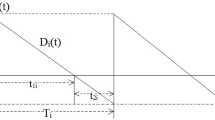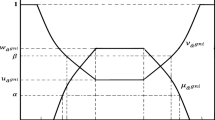Abstract
The observed values of demands in real-life inventory problems are sometimes imprecise due to the lack of information and historical data, thus a growing research is committed to study the properties of risk measures in fuzzy inventory optimization problems. In this paper, a risk-averse fuzzy optimization method is adopted for the multi-item inventory problem, in which the demands are described by common possibility distributions. Firstly, three classes of fuzzy inventory optimization models are built by combining the absolute semi-deviation with expected value operator and then model analysis is given for the min-max inventory models. To make the inventory problem tractable and computable, the equivalent forms of the proposed optimization models are discussed. Subsequently, several useful absolute semi-deviation formulas are presented under triangular, trapezoidal and Erlang possibility distributions. Finally, some numerical experiments are performed to highlight the modeling idea, and the computational results demonstrate the effectiveness of the solution method.



Similar content being viewed by others
References
Bai XJ, Liu YK (2014) Robust optimization of supply chain network design in fuzzy decision system. J Intell Manuf 27(6):1131–1149
Baykasoglu A, Gocken T (2011) Solving fully fuzzy mathematical programming model of EOQ problem with a direct approach based on fuzzy ranking and PSO. J Intell Fuzzy Syst 22(5-6):237–251
Bean WL, Joubert JW, Luhandjula MK (2016) Inventory management under uncertainty: a military application. Comput Ind Eng 96:96–107
Borgonovo E, Peccati L (2009) Financial management in inventory problems: Risk averse vs risk neutral policies. Int J Prod Econ 118(1):233–242
Chang SY, Yeh TY (2013) A two-echelon supply chain of a returnable product with fuzzy demand. Appl Math Model 37(6):4305–4315
Chen SP, Ho YH (2013) Optimal inventory policy for the fuzzy newsboy problem with quantity discounts. Inf Sci 228:75–89
Chen S, Wang H, Xie Y, Qi C (2014) Mean-risk analysis of radio frequency identification technology in supply chain with inventory misplacement: Risk-sharing and coordination. Omega 46:86–103
Chen Y, Liu Y, Wu X (2012) A new risk criterion in fuzzy environment and its application. Appl Math Model 36(7):3007–3028
Choi TM (2016) Multi-period risk minimization purchasing models for fashion products with interest rate, budget, and profit target considerations. Ann Oper Res 237(1-2):77–98
Choi S, Park K (2015) A risk-averse inventory model with markovian purchasing costs. Math Probl Eng. https://doi.org/10.1155/2015/925765
Dash JK, Sahoo A (2015) Optimal solution for a single period inventory model with fuzzy cost and demand as a fuzzy random variable. J Intell Fuzzy Syst 28(3):1195–1203
Feng XQ, Meng M, Liu YK (2015) Modeling credibilistic data envelopment analysis under fuzzy input and output data. J Uncertain Syst 9:230–240
Guo ZZ, Liu YK (2018) Modelling single-period inventory problem by distributionally robust fuzzy optimization method. J Intell Fuzzy Syst 35(1):1007–1019
He J, Jiang X, Wang J, Zhu D, Zhen L (2009) Var methods for the dynamic impawn rate of steel in inventory financing under autocorrelative return. Eur J Oper Res 223(1):106–115
Ji Q, Wang Y, Hu X (2016) Optimal production planning for assembly systems with uncertain capacities and random demand. Eur J Oper Res 253(2):383–391
Katariya AP, Cetinkaya S, Tekin E (2014) On the comparison of risk-neutral and risk-averse newsvendor problems. J Oper Res Soc 65(7):1090–1107
Lee SD, Yang CM, Lan SC (2016) Economic lot sizing in a production system with random demand. Int J Syst Sci 47(5):1142–1154
Li X, Wong HS, Wu S (2012) A fuzzy minimax clustering model and its applications. Inf Sci 186(1):114–125
Li YN, Liu Y (2016) Optimizing fuzzy multi-item single-period inventory problem under risk-neutral criterion. J Uncertain Syst 10(2):130–141
Li YZ, Wu QH (2016) Downside risk constrained probabilistic optimal power flow with wind power integrated. IEEE T Power Syst 31(2):1649–1650
Liang B, Park H (2007) Risk measures for hedge funds: a cross-sectional approach. Eur Financ Manag 13(2):333–370
Liu Y, Liu YK (2017) Distributionally robust fuzzy project portfolio optimization problem with interactive returns. Appl Soft Comput 56:655–668
Liu YK, Gao J (2007) The independent of fuzzy variables with applications to fuzzy random optimization. Int J Uncertain Fuzz 15:1–20
Liu YK, Liu B (2003) Expected value operator of random fuzzy variable and random fuzzy expected value models. Int J Uncertain Fuzz 11(2):195–215
Lu H, Wang H, Xie Y, Li H (2016) Construction material safety-stock determination under nonstationary stochastic demand and random supply yield. Trans Eng Manag 63(2):201–212
Sawik T (2013) Selection of resilient supply portfolio under disruption risks. Omega 41(2):259–269
Shaikh AA, Bhunia AK, Cardenas-Barron LE, Sahoo L, Tiwari S (2018) A fuzzy inventory model for a deteriorating item with variable demand, permissible delay in payments and partial backlogging with shortage follows inventory (SFI) policy. Int J Fuzzy Syst 20(5):1606–1623
Shi Y, Alwan LC, Tang C, Yue XH (2019) A newsvendor model with autocorrelated demand under a time-consistent dynamic CVar measure. IISE Trans 51(6):653–671
Stadje M (2010) Extending dynamic convex risk measures from discrete time to continuous time: a convergence approach. Insur Math Econ 47(3):391–404
Tekin M, Ozekici S (2015) Mean-variance newsvendor model with random supply and financial hedging. IIE Trans 47(9):910–928
Amiri-Aref M, Klibi W, Babai MZ (2018) The multi-sourcing location inventory problem with stochastic demand. Eur J Oper Res 266(1):72–87
Wu M, Zhu SX, Teunter RH (2013) The risk-averse newsvendor problem with random capacity. Eur J Oper Res 231(2):328–336
Yang GQ, Liu YK, Yang K (2015) Multi-objective biogeography-based optimization for supply chain network design under uncertainty. Comput Ind Eng 85:145–156
Zhai H, Liu YK, Yang K (2016) Modeling two-stage UHL problem with uncertain demands. Appl Math Model 40(4):3029–3048
Zied H, Sofiene D, Nidhal R (2014) Joint optimisation of maintenance and production policies with subcontracting and product returns. J Intell Manuf 25(3):589–602
Acknowledgments
This work was supported by the National Natural Science Foundation of China (No.61773150).
Author information
Authors and Affiliations
Corresponding author
Additional information
Publisher’s note
Springer Nature remains neutral with regard to jurisdictional claims in published maps and institutional affiliations.
Appendix
Appendix
1.1 Proof of Theorem 1
Proof
If we denote η = 1/ξ, then the credibility distribution of η reads that
Since the expected value \(m=\frac {1}{2(r_{3}-r_{2})}\ln {\frac {r_{3}}{r_{2}}}+\frac {1}{2(r_{2}-r_{1})}\ln {\frac {r_{2}}{r_{1}}}\) has computed in Li and Liu (2016), then if \(m\in [\frac {1}{r_{3}},\frac {1}{r_{2}})\), the absolute semi-deviation value E[(η − m)+] is as follows:
Similarly, if \(m\in \left [\frac {1}{r_{2}},\frac {1}{r_{1}}\right ]\), the absolute semi-deviation value E[(η − m)+] is computed by
We next to show that when r1 = 0, the absolute semi-deviation value E[(η − m)+] does not exist. In fact, the credibility distribution of η in this case reads that
Thus, the expected value m is computed by
which implies the expected value m does not exist, so the absolute semi-deviation value E[(η − m)+] does not exist either. The proof of theorem is complete. □
1.2 Proof of Theorem 2
Proof
If we denote η = 1/ξ, then the credibility distribution of η reads that
Since the expected value \(m=\frac {1}{2(r_{4}-r_{3})}\ln {\frac {r_{4}}{r_{3}}}+\frac {1}{2(r_{2}-r_{1})}\ln {\frac {r_{2}}{r_{1}}}\) has computed in Li and Liu (2016), if \(m\in \left [\frac {1}{r_{4}},\frac {1}{r_{3}}\right )\), the absolute semi-deviation value E[(η − m)+] is as follows:
Similarly, if \(m\in \left [\frac {1}{r_{3}},\frac {1}{r_{2}}\right )\), the absolute semi-deviation value E[(η − m)+] is computed by
if \(m\in \left [\frac {1}{r_{2}},\frac {1}{r_{1}}\right ]\), the absolute semi-deviation value E[(η − m)+] is computed by
The rest of theorem is similar to prove. The proof of theorem is complete. □
1.3 Proof of Theorem 3
Proof
If demand ξ is an Erlang fuzzy variable Er(λ, r), then the credibility distribution of η reads that
The expected value m of η is computed by
we find that the above formulation has different computing forms according to the values of r, if r = 1, then the expected value of η is computed by the formulation (14); if r = n, (n > 1), then the expected value of η is computed by the formulation (16).
Therefore, if \(m\in \left [\frac {1}{r_{2}},\frac {1}{\lambda r}\right )\), then the absolute semi-deviation value E[(η − m)+] is as follows:
By equation (19), we have the following result
Next, according to the different values of r, we present two cases to calculate the value of E[(η − m)+] when \(m\in \left [\frac {1}{r_{2}},\frac {1}{\lambda r}\right ]\).
- (i)
If r = 1, then the absolute semi-deviation value E[(η − m)+] is computed by the formulation (13).
- (ii)
If r = n, (n > 1), then the absolute semi-deviation value E[(η − m)+] is computed by the formulation (15).
Similarly, if \(m\in [\frac {1}{\lambda r},\frac {1}{r_{1}}]\), the absolute semi-deviation value E[(η − m)+] is as follows.
- (i)
If r = 1, then the absolute semi-deviation value E[(η − m)+] is computed by the formulation (17).
- (ii)
If r = n, (n > 1), then the absolute semi-deviation value E[(η − m)+] is computed by the formulation (18).
The rest of theorem is similar to prove. The proof of theorem is complete. □
Rights and permissions
About this article
Cite this article
Li, Y., Liu, Y. A risk-averse multi-item inventory problem with uncertain demand. J. of Data, Inf. and Manag. 1, 77–90 (2019). https://doi.org/10.1007/s42488-019-00005-y
Received:
Accepted:
Published:
Issue Date:
DOI: https://doi.org/10.1007/s42488-019-00005-y




